July 4,1999 : Radio Museum
by Mie
|
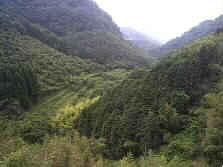 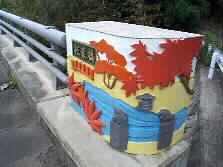
The torrential rain in the end of the rainy
season gave serious damages to Hiroshima
and Fukuoka. Here in Oita, however, we have
a cloudy sky with occasional sunshine today
on Sunday. A week ago, one of my Internet
friends in New York sent me a message, saying
"I have just read an interesting topics
on a Japanese newspaper published in NYC:
A unique 'Radio wave museum in Oita.' I can't
pass over the article because it relates
to my favorite Oita, in which you live. I
would be very happy if you report on the
museum." This is why we are heading
to the destination located in Asaji town.
On the way to the museum, we passed a deep
beautiful valley in thick green forest. The
bridge name over the valley reads "autumnal
tints."
|
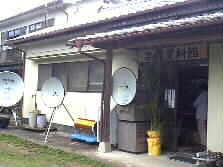
|
The museum is a part of a temple Myousenji
in Asaji town on the top of a hill of 300
meters in altitude. The two-storied museum
was newly opened last month. A couple of
large parabolic antenna are set on the ground. |
 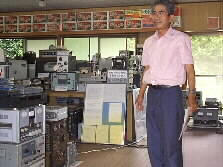
Since I made a phone call to the Museum in
advance, Mr. Koshiro, the master of the museum,
welcomed us together with his wife. I got
a brochure at the entrance (left.) He showed
me through the museum with detailed explanations.
In the museum (130 square meters) are so
many old historical radio gadgets that are
occupying all the walls and floor leaving
a narrow passage that leads to the second
floor. Included are antique radios, vacuum
tubes, and other mysterious parts densely
packed in corrugated cartons on the shelves.
All of them are finely sorted and arranged
in order.
|
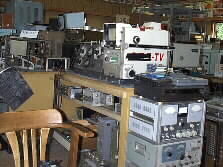
|
In the center (white box) is a TV camera
(TAYLOR-HOBSON) used in a TV station in Oita.
Mr. Koshiro's dream is to make the place
as a "Living museum of Showa era radio
technology." After 37 years' service
in a high school as a teacher of physics,
he retired last year and established the
museum. He hopes many fans will visit here
and talk over the technology. |
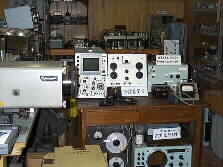
|
This is a spectrum analyzer. The extruding
white box is the lens of the TV camera mentioned
above. |
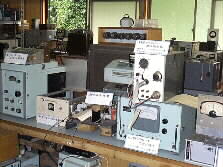
|
On the right is a micro wave output measure.
Many memos are attached on it, showing he
is looking for the parts required for repair
the gadget. He is busy in looking proper
parts for old radios in order to make them
alive. Over 80 % of his collection is in
"living condition." Though I am
just a stranger who can't estimate the value
of the collection, I still feel it is wonderful
to repair old tools and keep them for actual
use. |

|
On the slim tall box, a note is attached
that reads "Under experiment of micro
wave, since 1989." The wave is sent
out from a parabolic antenna on the side
of the entrance hall, reflected by a white
reflector standing in the garden, then received
by another antenna in front of the entrance
of the house. |
 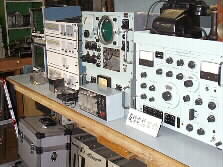 On the left is the masterpiece of Mr.
Seigo
Koga JA6AQO, one of the pioneers of
SSB in
Saga Pref.of Kyushu island. The set was introduced
in
April 1969 "CQ magazine."
On the
right are the devices of cable telephone.
On the left is the masterpiece of Mr.
Seigo
Koga JA6AQO, one of the pioneers of
SSB in
Saga Pref.of Kyushu island. The set was introduced
in
April 1969 "CQ magazine."
On the
right are the devices of cable telephone. |
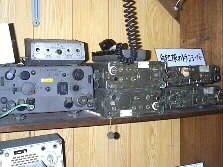 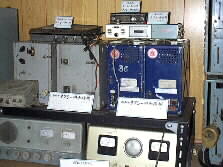 Left picture shows the transceiver sets once
used in Self-Defense Forces. On the right
is a history of taxi radio technology that
decreased the size of the gadgets dramatically:
two boxes in the bottom are controllers in
mid-1950s. Four boxes in the middle in gray
and blue are the radio receivers boarded
in a cab's trunk. Taxi drivers in those days
could catch the voice from the control station.
Top two black boxes are the improved receivers,
at last built-in the front panel of a cab.
Left picture shows the transceiver sets once
used in Self-Defense Forces. On the right
is a history of taxi radio technology that
decreased the size of the gadgets dramatically:
two boxes in the bottom are controllers in
mid-1950s. Four boxes in the middle in gray
and blue are the radio receivers boarded
in a cab's trunk. Taxi drivers in those days
could catch the voice from the control station.
Top two black boxes are the improved receivers,
at last built-in the front panel of a cab. |

|
US Air Force-use receiver R-28/ARC-5, loaded
on the US Navy's mid and larger-sized planes.
This transistor system enabled to receive
four channels of the radio wave ranging 100-156MHz
frequency. Ten vacuum tubes are used in a
set. Collins Co., manufactured and delivered
US Navy with the radios in 1942. Mr. Koshiro
purchased the set from Mr. Toshihiko Ishikawa
in Chiba prefecture, an expert of military
radios (cited from the brochure.) |
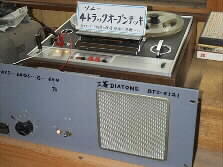
|
This four-track open deck records the voice
of Hideki Yukawa, the first Japanese Novel
prize winner for physics in 1949. He came
down to Oita in search for the achievements
by Baien Miura and Tanso Hirose, both of
them were the prominent local scholars in
late Edo era. At that time the Novel winner
made a speech in Taketa high school. Mr.
Koshiro then had been working in the high
school and recorded the voice. A Diatone
speaker of Mitsubishi played back the voice
in a very clear quality. |
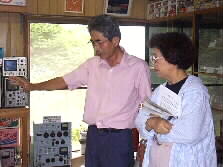
|
On the second floor is used as the display
room with a working corner. Green shade outside
of the terrace reflects the room brightly
and refreshing cool breeze carries the aroma
of thick greens. |
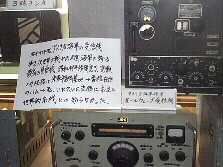
|
The top class US Navy's all wave receiver
manifactured in 1942, in the midst of Pacific
War. Mr. Koshiro got this machine in hand
by the rarest chance. The machine left US
base in Fukuoka and stocked in one of his
ham friends who offered Mr. Koshiro to take
it by free. Both of them weren't aware of
the fact that the machine was the highest-class
masterpiece of US Navy in that time. Mr.
Koshiro repaired it in 1975 and inspired
the life in it. It works perfectly, Koshiro
smiles.
|
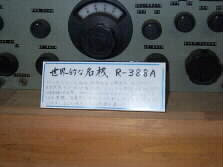
|
A world-famous radio R-388A (military code),
or 51-J-4 (public code), patented by Collins
was copied in Japan by JRC (Japan Radio Corporation)
under the license of the inventor and was
named as JRC-240J. The radio catches 30 bands
ranging 500kHz-30.5MHz covering whole 1 kHz
reading (cited from the brochure.)
|
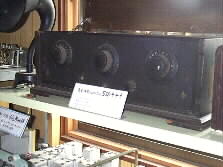 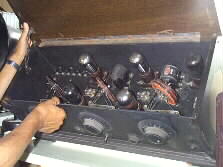 A Taisho-era radio manufactured in 1925 (left.)
The radio was widely used in the early days
of the public broadcasting from NHK Tokyo
station JOAK. The radio set was the copy
of American radio manufacturing company Cloister
who supplied the public with vast amount
of reasonably-priced radios. Five 201A vacuum
tubes are used and parts are of the products
in 1924 when they were regarded as high-class
components. In 1984, the set was repaired
by using substitutes and is working perfectly
(cited from the brochure.)
A Taisho-era radio manufactured in 1925 (left.)
The radio was widely used in the early days
of the public broadcasting from NHK Tokyo
station JOAK. The radio set was the copy
of American radio manufacturing company Cloister
who supplied the public with vast amount
of reasonably-priced radios. Five 201A vacuum
tubes are used and parts are of the products
in 1924 when they were regarded as high-class
components. In 1984, the set was repaired
by using substitutes and is working perfectly
(cited from the brochure.) |
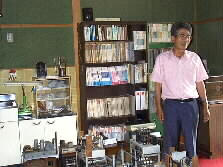
|
He also showed me his vast collection of
the magazines. |
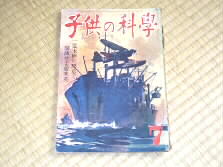 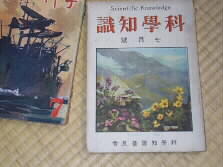 Those magazines are the treasures of
his
collection. On the left is a science
magazine
for children published in 1943. On
the right
is an older magazine "Scientific
Knowledge"
issued in 1926. It covers from the
principle
of electricity to alpine plants in
detail.
Those magazines are the treasures of
his
collection. On the left is a science
magazine
for children published in 1943. On
the right
is an older magazine "Scientific
Knowledge"
issued in 1926. It covers from the
principle
of electricity to alpine plants in
detail. |
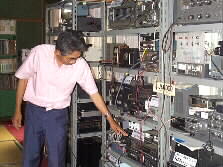
|
This is his radio terminal. His call sign
is JA6DDO licensed in 1962. He has been an
enthusiast of mechanics from his boyhood,
gathering old parts to build-up hand-made
radios. |
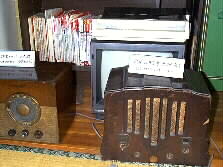 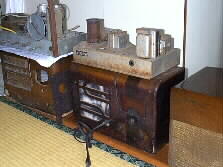 Old radios (left) are ready to work
perfectly.
They are restored by using new substitutes
when original parts are not available.
The
cases are cleaned with varnish and
polished
neatly. Other old radio sets (right)
wait
for restoration.
Old radios (left) are ready to work
perfectly.
They are restored by using new substitutes
when original parts are not available.
The
cases are cleaned with varnish and
polished
neatly. Other old radio sets (right)
wait
for restoration. |
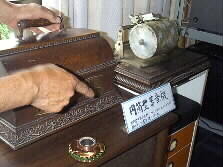 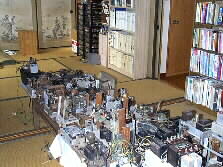 A cylindrical-type phonograph (left), similar
to the original one invented by Edison. The
cover of the treasure is made of wood carved
finely on the surface. The master of the
room is, of course, those old parts and trash-like
treasures, including various types of vacuum
tubes.
A cylindrical-type phonograph (left), similar
to the original one invented by Edison. The
cover of the treasure is made of wood carved
finely on the surface. The master of the
room is, of course, those old parts and trash-like
treasures, including various types of vacuum
tubes. |
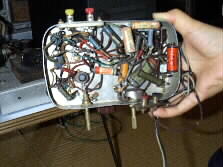 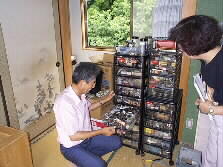 The top of his collection is this,
a hand-made
"aluminum lunch box radio"
(left.)
His more-important-than-life is stocked
in
those plastic cases.
The top of his collection is this,
a hand-made
"aluminum lunch box radio"
(left.)
His more-important-than-life is stocked
in
those plastic cases. |
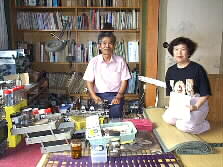
|
QC buffs will come and sit in this corner
on the second floor to enjoy pleasant chattings.
The break up parts and mysterious items must
be in their exact places memorized in his
head. |
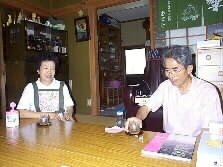 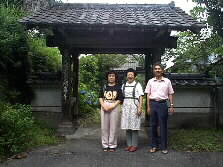 Mr. Koshiro explained us very eagerly, thank
you very much indeed. After a while, we were
invited to another room and had a pleasant
time including his wife. He is one year older
than my husband, we have to learn much from
them how to live a life after the retirement.
He is a Buddhist priest as well. We took
a commemorative pictures in front of the
main gate of the temple Myousenji. I felt
we could be good friends each other. I hope
to revisit here to talk more.
Mr. Koshiro explained us very eagerly, thank
you very much indeed. After a while, we were
invited to another room and had a pleasant
time including his wife. He is one year older
than my husband, we have to learn much from
them how to live a life after the retirement.
He is a Buddhist priest as well. We took
a commemorative pictures in front of the
main gate of the temple Myousenji. I felt
we could be good friends each other. I hope
to revisit here to talk more. |
 Hydrangea is in its best in the drizzle.
Hydrangea fits well with Asaji town,
a quiet
small community in the hill side of
Oita.
I am very happy to meet a wonderful
couple
today, but at the same time, I am afraid
this home page may contain many mistakes
in describing on the radio technology.
I
hope any of the experts will give give
comments
on it.
Hydrangea is in its best in the drizzle.
Hydrangea fits well with Asaji town,
a quiet
small community in the hill side of
Oita.
I am very happy to meet a wonderful
couple
today, but at the same time, I am afraid
this home page may contain many mistakes
in describing on the radio technology.
I
hope any of the experts will give give
comments
on it.
Radio Museum: location; 154-1 Ageotsuka,
Asaji town Oita prefecture. Phone 0974-72-1484,
Fax 0974-72-0156
|

































